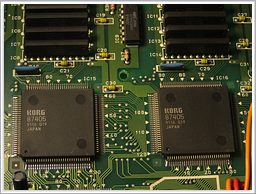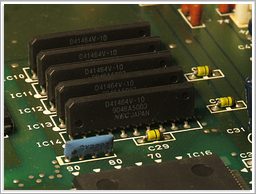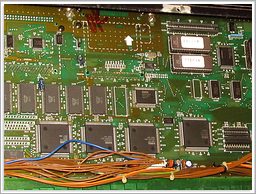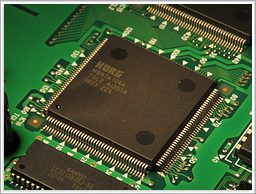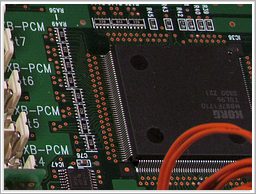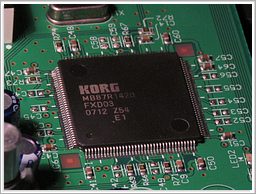Before we get to the Korg chips,
here are a few things I'd be happy if you could help me with:
Maybe you have the card or have downloaded a card image of Roland FANXRUP1 or FANXUP1
that was once floating around the web? If you have the card but don't
know how to create an exact backup of it, I'll help you with it - it's
easy. I've also kludged up an aternative upgrader v1→v2 package a very
long time ago, however it, while fully works, after starting up still
gets caught in some little trick that needs to be found out and fixed.
To fix it and make proper upgrader for everyone, I need someone that is
handy with SH3/7706 (HD6417706) disasembles and reverse engineering.
I've extracted and decompressed everything necessary and see the guilty
spot that needs to be patched, however I (at least currently) don't do
SH3.
Also, I'm looking for Yamaha PSR-2700 demo diskette contents that likely have been archived somewhere.
Maybe someone has a Yamaha PCS-30 (or PC-50, PCS-500, PC-1000) service manual and/or schematics
for it? Since I've made way over two hundred Playcards available to you
(and also tested absolutely all my binaries as well!), working out the
hardware and firmware of this thing is important, since this one,
instead of a custom playcard sequence playback chip, uses a stock Z80!
I'm looking for an Alesis WEDGE rom dump, Alesis XT:C rom dump and also Alesis XT-Reverb rom dump, Here's a MidiVerb dump for you in exchange. In fact, you can find tons of my dumped roms on this great webpage.
How come noone seems to have dumped Roland DDR-30 waverom?
I'm tempted to buy Bought one just to make dumps
(for all of you, btw!), but I already have a hundred more other synths
to desolder and dump in queue, so probably won't go for it. If you have
one - dump all the roms and let me know! It just should will be put on this great website. (already bought it and dumped program and all wave roms)
Any of the ART MultiVerb, ProVerb or similar reverbs/effect rom dumps are also of interest for me, for example I'm looking for ART Proverb 200 - here's an ART Multiverb LT dump for you in exchange.
Judging by the immense popularity of PSS-51 in eastern europe, asia and
amongst russians, it is quite hard to believe that no one have dumped
its roms. Maybe you have dumps of Yamaha PSS-51
program, abc and/or waveroms? Or maybe you know one for local pickup
somewhere within Baltic states? Well, just bought and dumped it, and extracted samples, demos and styles. Also I've previously made dumps of rather
similar PSS-795 and PSS-595.
It seems there that earliest version (A00) of the Yamaha FB01
firmware rom is somewhat rare, and I esimate, based on the units that I
have, that at most 10%-20% of the units in the wild do have it. All
usual ones have the most-likely-final C00, that I have desoldered,
dumped and shared in the long-ago ancient times. However, for the sake
of history and disassembly fun, having A00 dumped is a must as well,
though I don't realy have too much of spare time to desolder and dump
it, especially since maybe someone has already dumped this version
(given the popularity and abundance of these modules). So if you have
it, let me know. At some point I might desolder it and dump it, if it
turns out to be realy rare, but I'd better spend that time desoldering
and dumping something else.
Also, for the curious, initial hardware version (with A00 rom) only
differs with (besides missing ground wire from the pcb inside) that it
does not have a metal sub-chasis under the pcb, so you can tell that
from the outside by looking from the bottom: early ones have two holes,
but no screws in them, and instead has white plastic pegs in other
holes right besides front panel. Serial numbers for the A00 version
seem to be below 02000, while 07000 and up definitely has version C00.
No idea about if there was a B00 version in betwen 02000 and 07000.
(I will likely make a separate article on FB-01 at some point)
In regards to multieffect pedals - maybe you have a rom dump of Roland/BOSS GT-10B? There in this great webpage you can find my GT-3,5,6,8 dumps.
And maybe someone has already desoldered and dumped PSR-6000 waveroms?
Those are three pieces of DIP42 chips, each 2Mbyte (besides two more chips with styles and
then two DIP40 with program and demo songs). I am somewhat tempted to
grab one from the local trash market to do this, yet not sure if I
realy have to. And I don't have a clue when I could actually get to
desoldering it, even if I' ll grab one now. Still GEW9 stuff seems
rather interesting and not that common to come by in the keyboards.
Thanks, I now got the floppy files from Casio WK-1800 Accessory Disk (demo disk that came with it).
I will eventually make a page about this idea and what has been done
(if anything), but for now this text blob is just to keep the following
from the old post for those who are interested: You might like the main
reason I'm lookig for it - it is clearly a fun attack vector
to non-destructively dump its maskrom (in Hitachi H8) since it actually
allows to execute arbitrary code! While dumping can be done even by
blinking a led chdk-style, in this case there's already initialized and
working uart for that. Furthermore, if all is well, waveroms (8Mbyte total)
can also be dumped this way, since H8 can quickly access them, and
procedure to do this for studying will be in the maskrom. On the other
hand, I'll very likely at some point just desolder and dump waveroms
anyways - but it could be more epic to dump it via diskette and midi.
In regards to spare parts and hardware things that I'm missing, maybe you have this:
* Display from early 2000s - Kyocera KCG057QV1DB-G00 found in old Fantom-X keyboards (Roland part code: 03560889 "DISPLAY UNIT LCD KCG057QV1DB-G00").
If you do, please email me!
You've just stepped into
an unfinished page
So it is full of dummy placeholders and copied blocks of text. Don't take it too seriously.Korg DSP Chips
This section was overdue for more than a decade, sorry.
Despite a popular belief that I'm a yamaha chip and rom zealot, I am quite a harcore korg chip nerd as well. So there it
goes!
Korg Poly800 can actually be considered a CASIO.
Yep, you red that right - tone generator in it is a lowest-grade
single-chip primetive OKI (MSM5232), unable even to bend pitches for
individual voices (so no pitch envelopes and only a cheesy transistor
organ single common LFO vibrato) that pretty much prefectly explains
how that piece of crap sounds...
Sorry for the mess - take these notes as they are, as it's quite unlikely I will fix this page anytime soon.
MB = Fujitsu
I am going to grow the lists gradually, whenever I will find some spare time for doing it.
has amt.
Off-the-shelf DSP chips in korgs
This section was overdue for more than a decade, sorry.
Despite a popular belief that I'm a yamaha chip and rom zealot, I am quite a harcore korg chip nerd as well. So there it
goes!
Sorry for the mess - take these notes as they are, as it's quite unlikely I will fix this page anytime soon.
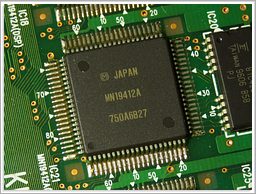 |
|
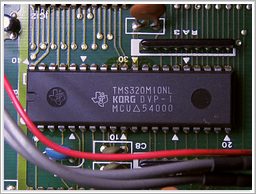 |
|
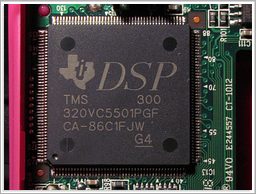 |
|
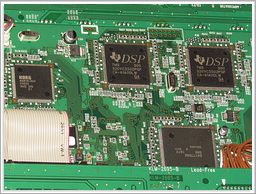 |
|
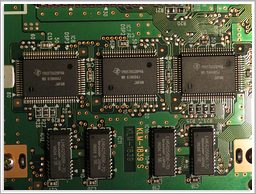 |
|
 |
|
I am going to grow the lists gradually, whenever I will find some spare time for doing it.
has amt.
S ries
The20).Rym.
D-7well).
| Chipset |
Features & capabilites |
Timeline |
Sound character |
Synths / effects processors |
| Dual TMS320M10 |
4-voice pitch shifters with pitch-synchronous splicing; approx 22kHz |
~1986 |
Low precision, glitchy and lo-fi harmony processing pitch shifters that use some primetive implementation of PSOLA algo. |
DVP-1 |
| TGI+TGII+VDF+MDE "AI" "Optinized Covolution" (sic) |
16 voices; 2 fx; 31.25kHz |
~1989 |
Dark, aliasy and pixely sound, but good. |
M1, M1R, M3R, T1/T2/T3 |
| TG88+DF88(+WS89)+MDE | 32 voices; up to 6 fx; 31.25kHz |
~1990..1994 TG88, DF88 developed in 1988; WS89 developed in 1989 |
Considerably dark but exceptionally tasty. If you like the Fifth Element and Sonic-CD soundtrack, this will absolutely be your cup of tea. |
O1/W, Wavestation |
| TG92+DF93+3x PanasonicMDE "ACCESS" |
32 voices; a couple of resonant filters for each voice; a ton of insert and master fx; 48kHz |
~1996..1998 TG92 developed in 1992; DF93 finalized footprint 1993/12/24 |
Airy and smooth - fantastic evolution of wavestation's character. |
Trinity, TR-Rack |
| Dual MDE |
48kHz (37.1kHz for A2, A3) |
~1991 |
Pixely, lo-fi-ishly oversaturated and exagerrated sound, yet strikingly enjoyable. |
A1, A2, A3 |
| TGL "AI²" |
32 voices; 2 fx; 31.25kHz |
Muddy, low fidelity; kinda like it to a degree, yet more of a guilty pleasure |
i1/i2/i3, |
|
| TGL2 "AI²" |
32 voices; 2 fx; 31.25kHz | Muddy, low fidelity; kinda like it to a degree, yet more of a guilty pleasure | ||
| Dual TGL2 "AI²" |
64 voices; 2 fx; 31.25kHz actually capable of 4 fx, but korg didn't care to implement it in main firmware; |
Muddy, low fidelity; kinda like it to a degree, yet more of a guilty pleasure | X5D, X5DR |
|
| TGL96 "HI" |
~1997 |
It's good. | TR61, TR88, MicroX, X50, Triton Le, PA50 |
|
| Dual TGL96 "HI" |
~1997 | It's good. | Triton (all non-Le), Triton Extreme/Ex |
|
| TMS320VC5501 | most if not all Kaossilator, Kaosspad |
|||
| TMS320VC5502+FXD03 "MMT" |
8 voices; 5 fx; 48kHz |
~2007 |
Besides low polyphony, it's good. | R3 |
| Dual TMS320VC5502+FXD03 "MMT" |
24 voices; 5 fx; 48kHz | ~2005 |
It's good. | Radias |
| FXD03 |
AX3, AX5 and a lot of other pedals |
|||
| Dual TMS57002BPHA | 48kHz |
A4 |
||
| Triple TMS57002BPHA |
~1995 |
Prophecy, Solo-Tri |
||
| TMS57070FFT |
~2000 |
Electribe EA1, EM1, ES1 |
||
| Twelve TMS57070FFT + PanasonicMDE "MOSS" |
12 voices |
~1998 |
It's good. | Z1 |
| DSP56362 |
too few voices, and a very crappy primetive fx; |
~2002 |
Chip
is great, but korg's sound on it is not. There are fun aspects to
MS2000, don't get me wrong - I do have a bunch of MS2000 myself. But it
is nothing to write home about. All the tales about legendary-ness of
those are bullshite stories from ebay sellers parroted by wannabe reviewers. |
MicroKorg, MS2000 |
| NEC uPD77213 "MMT" |
~2004 |
Incomparable sonic upgrade to the original cheesy electribes. Aaah, if only EMX had an actual editing of sounds, instead of that basic single-function few knob abomination. |
EMX-1, ESX-1 |
|
* - multiply
By the way, all byte multiplicators k and M here are Si - meaning x1000 and x1000'000 respectively, and in most cases are precise byte values, rounded to whatever looks good in the table.
